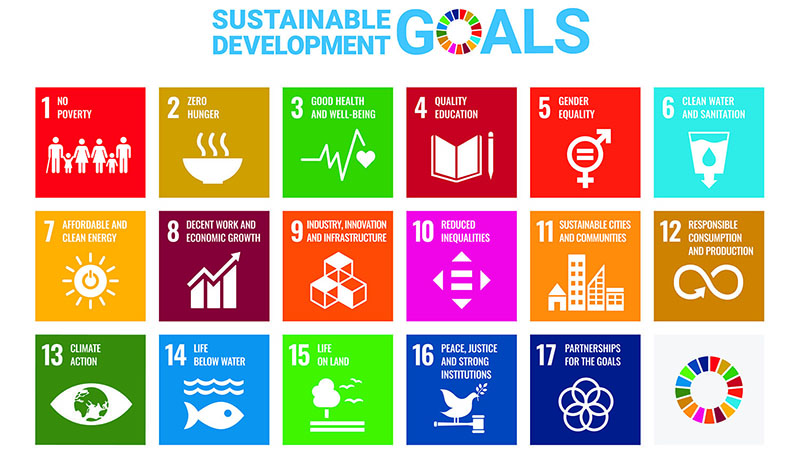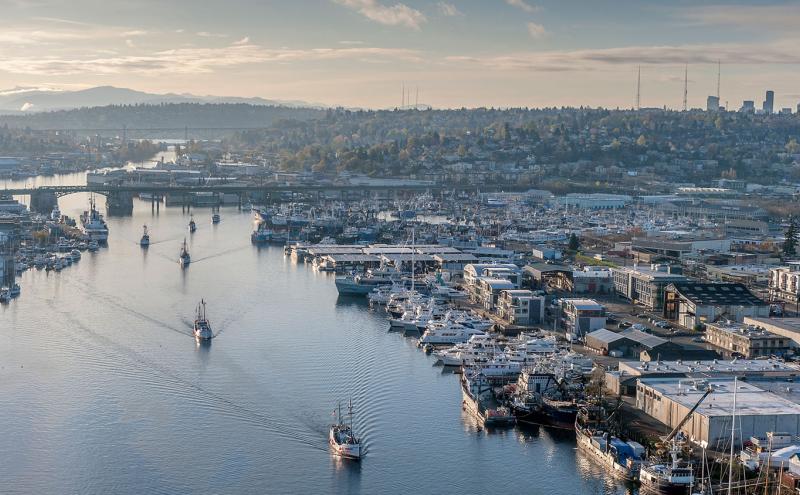
Today marks the 54th anniversary of Earth Day, a global movement dedicated to protecting our planet. As we celebrate our shared responsibility for a healthy planet, we reflect on how the Port of Seattle's work aligns with and supports the United Nations' Sustainable Development Goals (SDGs), a global blueprint for a healthier, more equitable future.
The SDGs are a comprehensive framework for achieving a more sustainable future, and the Port is committed to playing its part. Through the Port’s Century Agenda, the directional compass that establishes our ambitious vision for the next 25 years, we're actively pursuing initiatives that address climate change, restore and protect ecosystems, and promote economic prosperity for all. The SDGs consist of 17 global goals that address the most pressing issues in the world today: poverty, inequality, and climate change. The Port’s work directly ties to 14 of these. Here’s how:

Promoting inclusive growth (SDGs 1, 4, 5, and 8):
The Port of Seattle actively supports small businesses and creates opportunities for local communities. Our Century Agenda includes specific goals to foster inclusive economic growth (Goal 8) by:
Increasing spending with WMBEs
We've set ambitious targets to increase spending with women and minority-owned businesses (WMBEs) (Goal 5). In 2023, the Port exceeded its five-year goal of tripling the number of WMBE firms working with the Port annually. We achieved a 12.4% WMBE spend across all our projects, totaling $77.7 million — a significant contribution to regional economic growth.
Supporting small businesses
The Port's Century Agenda also focuses on empowering qualified small businesses. Through our PortGen and Business Accelerator Program, we provide mentorship, training, and resources to help small businesses navigate public contracting procedures and compete for Port projects. This program equips them with the skills and knowledge needed to grow their businesses and contribute to the local economy (Goals 1 and 5).
Green jobs
The Port’s Green Jobs program focuses on two key areas: upskilling the local community and supporting green career pathways. We partner with organizations like Seattle Jobs Initiative to identify in-demand green jobs in the maritime industry, such as electricians and heating, ventilation, and air conditioning (HVAC) technicians. Additionally, we offer training programs and resources to help individuals from historically disadvantaged communities enter and excel in these green fields. This approach not only strengthens the Port's environmental efforts but also fosters a more inclusive and sustainable future for the regional workforce.
Building a sustainable future (SDGs 3, 6, 7, 9, 10, 11, 13 and 14):
Environmental stewardship is a core value at the Port of Seattle. Our Century Agenda prioritizes goals and programs that address climate change (SDG 13) and ensure a sustainable future:
Electrifying the waterfront
The Port is actively electrifying its infrastructure to reduce reliance on fossil fuels. This includes installing shore power connections at berths so that docked ships can plug in and use clean electricity instead of running their diesel generators. Additionally, we’re exploring electric options for cargo-handling equipment like cranes and yard tractors.
Clean fuels
The Port is investigating and implementing the use of cleaner-burning fuels for various operations. This could involve switching to biofuels for harbor vessels, electric or hydrogen-powered drayage trucks for transporting cargo, and sustainable aviation fuels for airplanes. We are also collaborating with industry partners to explore the development of a first-of-its-kind green corridor for zero-emission cruise ships traveling between Washington, British Columbia, and Alaska.
Renewable energy
Recognizing the importance of renewable energy sources, the Port is exploring partnerships and opportunities to incorporate wind, solar, or other renewable energy sources to power its facilities and operations.
Energy efficiency
Beyond switching to cleaner fuels, the Port is continuously seeking ways to reduce overall energy consumption. This might involve optimizing building management systems, using energy-efficient lighting and equipment, and implementing conservation measures across all Port facilities.
Sustainable Evaluation Framework (SEF)
The SEF goes beyond traditional cost-benefit analysis of sustainability actions. This framework assesses the environmental impact of capital projects during the planning stages, ensuring infrastructure development is sustainable in the long term (Goal 9). It also promotes inclusive growth through initiatives like requiring participation from Women and Minority-Owned Businesses (WMBEs) and prioritizing workforce development programs. Additionally, the SEF fosters innovation by encouraging the exploration and implementation of clean energy solutions throughout Port operations. This multi-faceted approach ensures the Port's projects contribute to a sustainable and equitable future for both the port operations and surrounding communities.
Ensuring clean water and sanitation (SDG 6)
The Port takes its commitment to clean water seriously. Both the airport and seaport have dedicated stormwater management and remediation teams that not only meet regulatory requirements but also explore innovative green solutions. These strategies include treating stormwater runoff with natural filters, removing derelict vessels that pose environmental hazards, and cleaning up historical contamination to safeguard public health and the environment.
Protecting our planet (SDGs 14 and 15):
The Port of Seattle recognizes the importance of healthy ecosystems (SDGs 14 and 15). We demonstrate this commitment by focusing on restoring and creating habitat in our local watersheds. Here are some key examples:
Habitat restoration and enhancements
The Port works diligently to restore critical habitats, like the ongoing work at the Duwamish River People's Park. This habitat restoration project creates valuable public green space while revitalizing habitat for native fish and wildlife. In 2023, after 20 years of clean up and restoration, and one year after opening, researchers found 247 natural-origin Chinook juvenile salmon and 2,352 chum salmon, and an improved estuarine habitat.
The Port recently adopted a Land Stewardship Plan and Tree Replacement Standards to formalize Port efforts to balance benefits to the environment and communities with airport operations. Building upon the Port's well-regarded environmental leadership, these strategies further strengthen SEA Airport's commitment to sustainable planning, operations, and development.
Looking ahead
The Port of Seattle's commitment to sustainability goes beyond Earth Day and these highlighted examples. The Century Agenda serves as a comprehensive roadmap, guiding continuous improvement to ensure our operations contribute to a healthier planet, a thriving economy, and a more equitable future for all. By aligning with the U.N. Sustainable Development Goals (SDGs), our local actions hold global significance. Aviation and maritime industries are inherently international, and our efforts extend beyond Seattle. We share knowledge and best practices with other ports, working collaboratively to achieve emissions reductions and environmental improvements on a global scale. In this way, the Port of Seattle strives to be a leader not just in our region, but for sustainable maritime and aviation practices worldwide.










